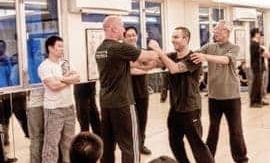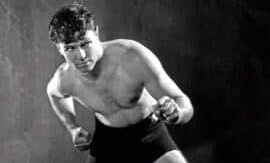
STARTING HIS TRAINING IN MARTIAL ARTS IN HIS YOUTH, SIFU SUNNY SO WENT ON, STUDYING AND MASTERING DIFFERENT ARTS, SUCH AS OKINAWAN KARATE, ANCIENT WHITE CRANE, AND CHI SIM WING CHUN (OR AS MANY PREFER TO CALL IT, WENG CHUN), BECOMING THE LAST STUDENT OF THE LATE GRANDMASTER TANG YICK.
Many people nowadays talk about the connection between those styles. Do you agree with such a connection?
I clearly see an interconnection between those styles. With modern Karate and Wing Chun, there isn’t any evident connection, but when linking both to Fujian White Crane, they have many similarities. In particular, the Weng Chun style, compared to Wing Chun, shares a lot of techniques and theory with it. The most similarities are found in the form Sap Yi Sao, our mother form. I believe the connection with Karate was much stronger earlier, but nowadays, has become a sport—it’s almost lost.
Many people know little about Weng Chun. Can you give us a brief insight into it?
My Sifu believed that Weng Chun and Wing Chun were one in the past, but at some point, they diverged and took different paths. They still share very similar principles, but the forms and the study curriculum differ greatly from both styles. Weng Chun still has the Southern Shaolin influence, but it should be performed in a soft, powerful way like a rattan stick, not stiff like we see many styles do nowadays. Being soft doesn’t mean there is no power—quite the opposite! In the past, someone referred to Weng Chun as Southern Taiji (or Nam Tai Gek), cause the way it was performed and also for the similarities of some techniques.
How does the syllabus differ from traditional Wing Chun?
In Weng Chun, we have two basic forms: the Sap Yat Sao (aka Weng Chun Kuen) and the Jong Kuen, as well as an advanced form called Seung Kong. Other Weng Chun families also include the Sam Bai Fut but are not from the Tang Yick family. The Sap Yat Sao is divided into 11 sections and gives us the basic principles and the Ging (“Energies”) to be developed in this style. The Seung Kong share very similar principles and techniques from the first form but include footwork that helps the students to understand the different movements into space and use of the body to generate power while moving.
The Jong Kuen comes from another family but was also included. It’s an empty-hand form, but refers to the Jong (“Wooden Dummy”) and focuses on studying the different distances of fighting: the short range and the long range. It’s somehow similar to the Sam Bai Fut, but the latest focus is even more on long-range fighting.
We also have three Wooden Dummy forms called Heaven, Earth and Human. The Heaven set comes from the Chu Chung Man family while the Human set comes from our Tang Yick line. The source of the Earth set is still unclear. The Heaven set focuses on fighting the opponent square on. The Human set focuses more on taking the side or the lower part and also includes throws. The Earth set focuses on a very short distance but doesn’t focus on sticking to the opponent like the first two sets, but is more about generating fast, short power. We also have two Long Pole forms and one Knife form called Sap Yin Do, which differs from the Wing Chun one because it’s a continuous form used for fighting, and every action is a chop or a cut.
You mentioned there are different energies to be developed within the Sap Yat Sao. Can you elaborate on that?
We have four kinds of different energies that must be developed while training the first form: Earth, Water, Fire and Wind. The Earth element makes sure that every movement and the structure is connected to the ground because the ground is the mother of the energy. This means that my whole body, the neck, the Kwa and the feet should be interconnected. The Water element is about developing soft energy, like a Tsunami, but also to be flexible enough to change and feel your opponent. The Fire element develops the hitting power at a very short distance, what many styles call Fa Jing, sending out our energy with minimal movement and maximum power. The Wind element is the one that is most misinterpreted because they think it is about speed. However, Wind means not to intercept the opponent’s force directly, but to absorb it, following his or her power to then let it go. Those four energies are initiated in the first form but can be developed throughout the entire system, becoming the way we move and generate power.
Grandmaster Tang Yick was known as the “King of the Long Pole”. Can you tell us a little about this and how it is used in your style and what are the differences to other lineages?
My Sifu was incredibly skilled with the Long Pole and they also called him “The Bee”, because you could barely see his movement coming but you would feel the “sting” that had just bitten you. The Tang family has always emphasised the Long Pole, so Grandmaster Tang Yick had to practise it every morning before he could have any breakfast! He was not a tall person, but he trained with a 12-foot tall pole instead of the traditional 9-foot, and he could generate and develop lots of Internal power with it.
The main difference is that our form is much longer and we train many positions and cover many angles with it. The principle is similar to other lineages, but we put a lot of focus on it and we might have a more complex form. We have two different Long Pole sets: the Lok Dim Bun Gwan and the Gwan Gong; we also train them with the Gwan Jong, the Wooden Dummy for the pole, to develop combinations and to have a reference to control different angles of attacks. Most important is that when we move, the attack must be delivered with the whole body.
You also have a different way to train Chi Sau. For us, Chi Sau is mainly to develop sensibility and reactions. We also focus on not grabbing the partner, because we think it will be like losing one of your weapons and every motion should be an attack whenever possible. We are at close range, so I can’t waste my time rolling arms, any chance is a hit, either for my partner or me, and we need to capitalise on that and also be very direct.
Does Weng Chun also have Internal training?
We do, and we focus a lot on full body movements within our forms—we have three main Jam Jong standing positions to develop basic Internal power and alignment, and focus on the delivery of the movement and the energy.
What is your hope for the future of this art?
In the past, Weng Chun and Wing Chun were one, then they interconnected many times in history: during the Red Boat period; in Fatshan with the exchanges between Dr. Leung Jan and Fong Siu Ching; then again in Hong Kong with Ip Man and the “Dai Dak Lan”. In the past, people clearly used to share and expand their knowledge, it’s only nowadays that people are getting stuck in their style and are slowly closing their minds to the potential of sharing the knowledge coming from this beautiful art. I hope future generations will open up and do like those great masters of the past.



















